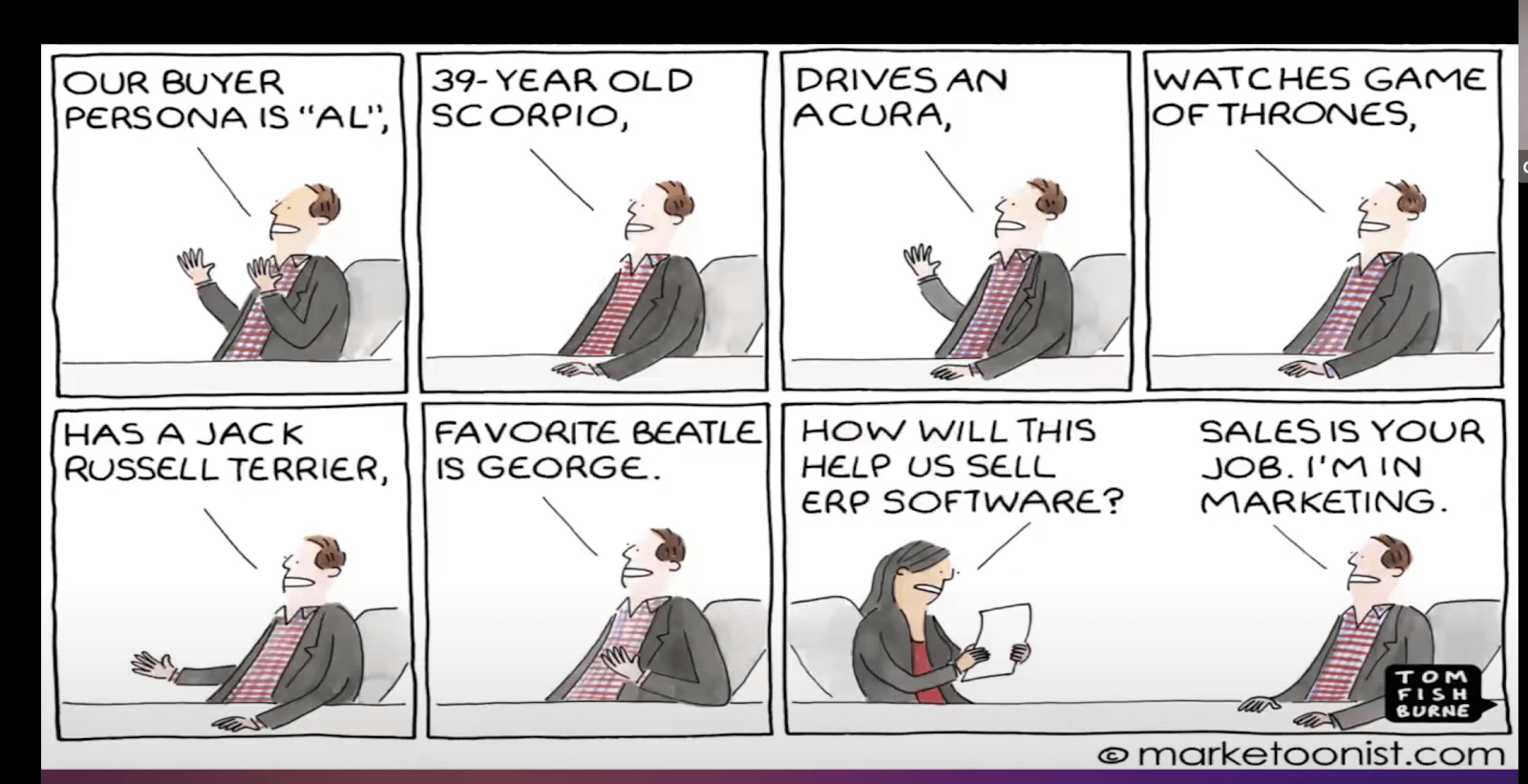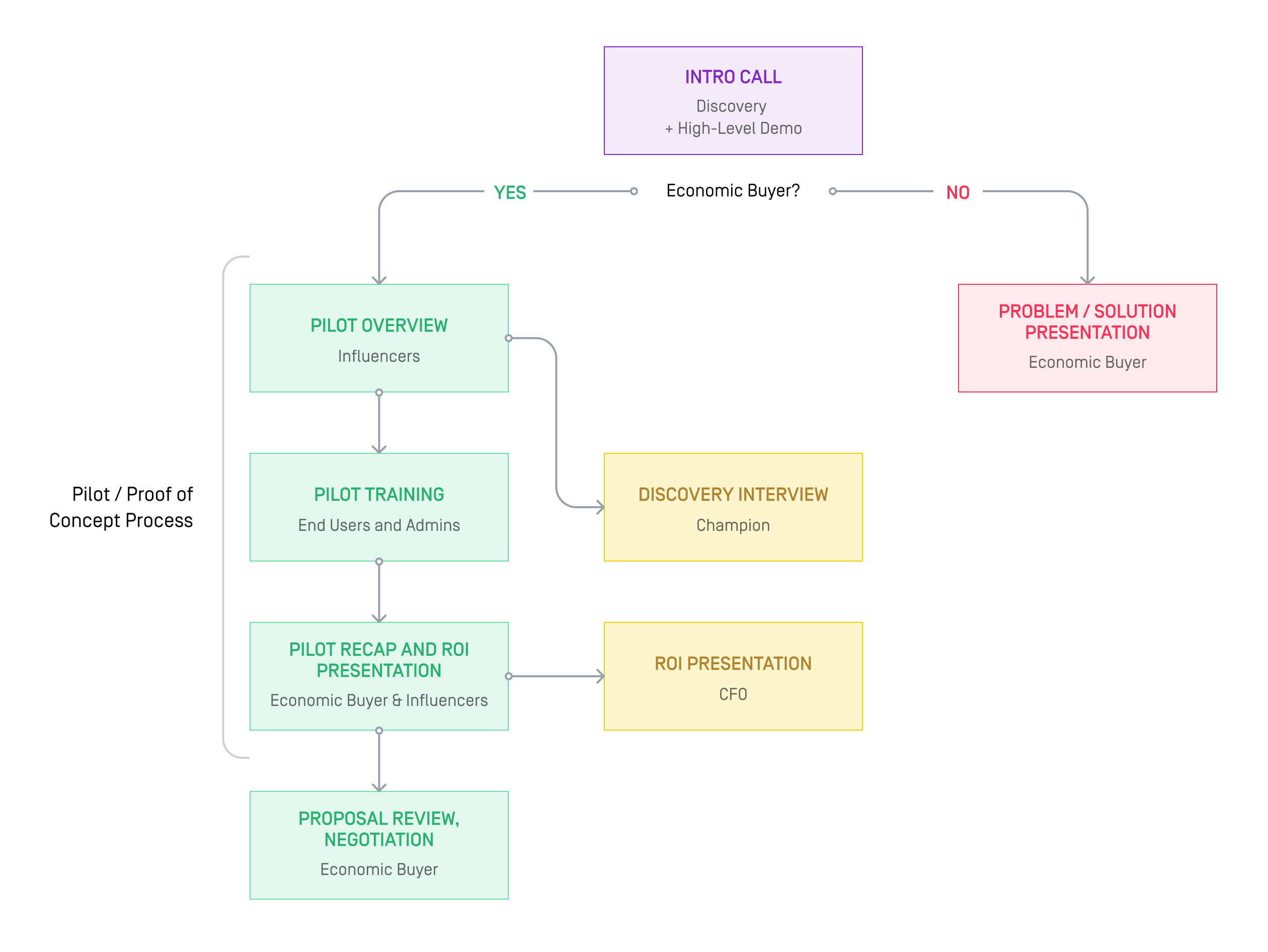Build a robust B2B sales strategy framework in 7 steps
All sales organizations are masters of sales tactics.
We know what opening lines to use on a cold call.
We know what questions to use in a discovery call.
We know how to lock down next steps or overcome the next objection.
And while tactics are important, a sound sales strategy is critical to improving your closed/won ratio.
Here is the 7-step framework for crafting a bullet-proof sales strategy in 2021.
SALES STRATEGY STEP 1: BUILD AN IDEAL ACCOUNT PROFILE
Without accounts, there are no sales.
The key in this step is to define who you should be targeting, finding your “ideal” account profile.
A good targeting strategy asks:
- Who should we target?
- What are their criteria?
- What do they look like?
- What technographics and psychographics do they have?
- Where are they located?
All of the above is important, and necessary, for good targeting.
To go from good targeting to great targeting, ask all of those questions AND, “who should we NOT target?”
An example — one that plays out far too often in sales organizations around the globe:
An SDR comes across an account that is in the “gray area.” It’s easy to rationalize how a company is “kinda in our ideal account profile.”
So the SDR targets that account.
The AE either (a) disqualifies, or (b) starts to work the no-chance-of-closing deal.
Scenario A: Good
Scenario B: Not so good
Unfortunately, scenario B happens more often. The AE begins to work that account and spends the next 60/90/120 (!!) days spinning their wheels working an account that has little if any chance of closing.
The key is to remove (or at least significantly reduce) the gray area.

✔️ Don’t assume your sales team knows this as well as you.
✔️ Train continuously: recommend quarterly
✔️ Who to target? Who not to target!
Building the account profile is the first step in any sound sales strategy.
P.S: Need some inspiration to get started? Grab this free sales strategy template to kickstart your revenue strategy.
SALES STRATEGY STEP 2: SET UP BUYER PROFILES/PERSONAS
Now that you know which accounts to (and not to) target, it’s time to identify the individual buyers within those accounts — buyer personas/profiles.
Buyer profile: the second step in any rock solid sales strategy. Ask (and answer):
Who are the players in the sales cycle?
What are their objections?
How do we talk to each one differently?
But first, here is how NOT to do it (and unfortunately how so many buyer personas are built):

When marketing organizations are not sales driven, you end up with the above scenario. Marketing builds a buyer persona that is filled with a bunch of information that does not help sales do anything!
While much of the information may be helpful to another marketer, salespeople only care about the information that will help them navigate the buying process and close more deals.
Here is what makes a buyer persona useful… to a salesperson:
- Based on reality, not guessing or assuming (yes, you’ve heard that before): Interview customers and prospects. Talk with customers immediately after a deal is done (win or lose). The risk of talking to long-term customers is the conversation tends to evolve into the product and features they like/don’t like. Helpful, but not the full picture.
- How to speak with each persona: Remember, the talk track can (and should) be different depending on the buyer persona.
- What questions to ask: Will vary by persona
- What objections each persona will likely surface: Will vary by persona
- How to navigate through the sales process per buyer personas: At Gong, we start with the VP of Sales and then work our way to enablement. This process will likely be different at your organization.
Chris recommends interviewing 7-10 people for each persona — with a mix of prospects and customers (leaning on new customers). Also, this is not a one and done exercise. Keep these interviews going on a monthly basis.
Note: We use our own product — Gong’s Revenue Intelligence platform — to help build out personas. We listen to hear what language our prospects and customers are using.
SALES STRATEGY STEP 3: CREATE A MARKET-DRIVEN SALES PROCESS
As the subheading states, this sales strategy is a market-driven sales process. You’ve done the hard, yet necessary, work in setting up your sales strategy in steps 1 and 2. Now it’s time to use it!
Build a rhythmic sales process — a true strategy — that predictably converts demand into revenue.
Phew! That’s a lot of big sales words. Said another way:
Identify the repeatable sales conversations your reps will have in the journey from a new meeting to closed/won. Be sure to include calls, meetings, and emails.
Here is the sales flow we use at Gong:

While your sales process (flow) may not look exactly as the one pictured above, feel free to steal this and tweak it to make it your own (and add to your sales strategy arsenal).
PS: The only way to effectively track how well (or not) your sales process and strategy are applied in the field is by running airtight pipeline reviews. This checklist will help you do just that: get it for free.
SALES STRATEGY STEP 4: BUILD A CUSTOMER CONVERSATION MAP
Customer conversations are at the heart of any formidable sales strategy.
(They also happen to be something Gong is really good at capturing.)
When thinking about customer conversations, first define what good looks like.
Build a customer conversation map — a matrix your sales team can use to understand how they can message to their buyers based on:
- the business problem you are solving,
- the buyer persona you are addressing, and
- the stage in the sales process
The first step is to identify the predictable, repeatable business problem(s) your company solves.
For each problem, determine what the buyer is thinking and guide them through asking/answering/answer the following:
- Active pain: I have a problem.
- Solution development: What’s the cause? What approaches are available to solve? What’s the best one?
- Solution mapping: How will X solution help me solve the problem? Does it address each pain point?
- Summarizing value: What’s the big picture value I get?
- Proof: How can I be sure? Who else like me has done this? What were their results?
Then, build out the talk track (aka, messaging) you want your reps to use:
Let’s take the first part, active pain (I have a problem). Your job as a seller is to use the appropriate messaging to address (ideally solve) their problem.
Then, move on to the next part, solution development. Again, your job is to guide the buyer to your solution using the approved messaging.
And so on…
A solid customer conversation map ensures that each message, at each stage, addresses exactly what the buyer is going through at that moment.
Finally, once you’ve nailed all of the above, build out a searchable, sortable library (see: Gong) of what “good” looks and sounds like — record the call and make it easily accessible to each and every sales rep.
SALES STRATEGY STEP 5: REVERSE ENGINEER A DEMAND ENGINE
Demand generation: Getting leads in the pipeline.
Building that demand “engine” is critical to moving the sales train (see what I did there?).
The key: reverse engineering your numbers so you know what to expect from marketing AND understand what your reps should be self-sourcing (their own prospecting).
Here’s how it’s done.
Ask yourself:
- What number do you need to hit?
- What is your average deal size?
- What is your close rate?
#2 and #3 will tell inform the number of opportunities you need in your pipeline to hit #1.
Now, how many opportunities are you actually getting from marketing? How many can you expect? And where is the gap?
The gap between marketing opportunities (actual + expected) and total opportunities to reach your sales goal is the amount of prospecting your team needs to be doing.
Next level sales organizations take this a step further, getting even more granular. These teams break down the exact number of prospecting hours per sales rep in order to generate expected opportunities.

SALES STRATEGY STEP 6: STANDARDIZE TRAINING & CERTIFICATION
The first five sales strategy steps set the groundwork for training and certification. You must do these 5 first — and do them well — before you can even consider this step.
Train your team on the sales process and repeatable steps. Understand what works and standardize it.
This is true for both new hires and you sales vets out there.
The key in this step is to certify your reps after the training. Certification can be accomplished in many ways — and may be unique to each organization. No matter how you get it done, ensure it’s… done. There must be some way to measure the following:
- Are reps drinking the sales kool-aid?
- Are they doing everything you’ve trained them to do?
Example: A new product launch.
After training up sales reps on how to best message this new product, set up a role-play scenario where salespeople can show off their new knowledge. That’s the easy part.
The next step of certification: A live “combat.” Within 10 days of completing the role play, have reps go through an actual prospect call to confirm they can properly message the new talk track.
Using Gong for the above is highly recommended!
SALES STRATEGY STEP 7: EXECUTE ONGOING COACHING
The final sales strategy step is not really “final.” As the title indicates, coaching is never one-and-done. Coaching is ongoing.
If you think about coaching as a line graph, a sales rep’s knowledge increases immediately after a coaching session (good!). However, as time continues, that knowledge begins to flatten out (or even decrease (not good).
Ongoing coaching eliminates these dips in knowledge retention and helps attain the ultimate goal: Turning underperformers into stars.
But how do we know if this ongoing coaching is actually working?
One word: Measure.
Measure every rep regularly on what’s most important (see above steps!).
TURN PIPELINE REVIEWS INTO A WELL-OILED MACHINE
It’s the meeting that gives you confidence in all other meetings.
It’s your sales strategy in motion.
And it’s the weekly checkup on how your strategy is performing you can’t afford to miss.
That is, if you’re making the most out of them.
This checklist is your shortcut past shot-in-the-dark sales forecasting and to understanding what’s really in your pipeline.
Grab the 7-Point Checklist For Airtight Pipeline Reviews and get your sales strategy up and running. Week in, week out.
